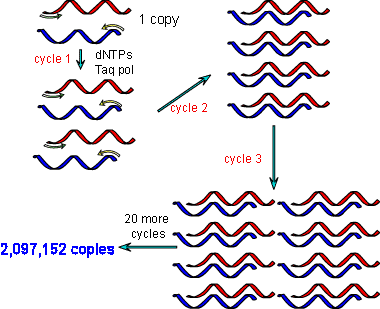POLYMERASE CHAIN REACTION
(August 2003)
The Polymerase Chain Reaction (PCR) is an important tool for many applications. For example, it can be used to amplify a sample of DNA when there isn’t enough to analyze (e.g. a sample of DNA from a crime scene, archeological samples), as a method of identifying a gene of interest, or to test for disease.
The method uses specifically designed primers that are complementary to the sequence to be amplified. The primers provide a starting point for the extension of the DNA by a DNA polymerase (usually Taq or Pfu polymerase). Amplification is carried out in cycles. First, the DNA sample is heated up to separate the double strands. The sample is cooled slowly, allowing the primers to bind. Then, the sample is incubated at 72°C so that the DNA Polymerase can extend the primers, creating a long complementary strand of DNA. In this way, one double strand of DNA becomes 2, 2 become 4, 4 become 8 and so on.

See this page for an excellent demonstration of PCR.
How is PCR used?
PCR has become an important tool for medical diagnosis. PCR can detect and identify bacteria and viruses that cause infections such as tuberculosis, chlamydia, viral meningitis, viral hepatitis, HIV, cytomegalovirus and many others. Once primers are designed for the DNA of a specific organism, using PCR to detect the presence or absence of a pathogen in a patient’s blood or tissues is a simple experiment.
PCR is also used in genetic testing, to determine whether patients carry a genetic mutation that could be passed on to their children (e.g. the mutation that causes cystic fibrosis) or to determine disease risk in patients themselves (e.g. a mutation in the gene BRCA1 predisposes a woman to breast or ovarian cancer). PCR is used to amplify the gene, which is then sequenced to look for mutations.
PCR is used in genome sequencing, including the Human Genome Project. Using random primers (not a specific sequence), the entire genome of an organism can be amplified in pieces. Once the pieces are amplified, they must be sequenced and then put back together to determine the genome sequence.
Scientists can gather information about evolutionary relationships using PCR on ancient samples. Genes from various related organisms are amplified, sequenced and then analyzed for similarities/differences. If two organisms have very similar genetic sequences, they are most likely closely related.
(Art by Fan Sozzi)